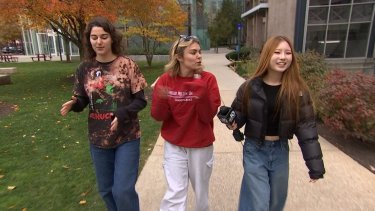Boston, MA
Celtics’ Jaylen Brown reportedly played through partially torn meniscus

We knew Jaylen Brown was battling a knee injury during the Celtics’ playoff run. Now we know the severity of the ailment that has hampered the Boston star since March.
Brown played the last part of the season with a partially torn meniscus in his right knee, according to ESPN’s Ramon Shelburne. Brown will be evaluated this week to determine if he’ll need to undergo surgery during the offseason.
Brown started receiving injections in his knee back in March to help with the injury, and missed six games over a 13-game stretch late in the season to rest up before the playoffs. He was able to play through the injury and suited up for all 11 of Boston’s postseason games, and though Brown lacked his usual explosiveness, he was still able to average 22.1 points, 7.1 rebounds, and 3.9 assists per contest for the Celtics.
“I don’t make excuses,” Brown told reporters after Boston’s season-ending loss to the New York Knicks on Friday night. “Obviously, it’s tough the way we went out like tonight, but the way we finished the year, personally, the way I finished the year, persevering through some physical stuff that I was battling through, I’m proud of our group.”
News of Brown’s injury further complicates an already iffy offseason for the Celtics. The team is already facing the likelihood of playing all of next season without superstar forward Jayson Tatum, who underwent surgery for a rupture Achilles last week in New York. With Brown’s status now in question, there’s a chance the Celtics will be without their two best players to start the 2025-26 NBA season.
After taking home MVP honors in the Eastern Conference Finals and NBA Finals last summer, Brown averaged 22.2 points, 5.8 rebounds, and a career-best 4.5 assists over 63 regular-season games for Boston in 2024-25.
Jaylen Brown staying optimistic after Celtics postseason loss
The Celtics’ title defense ended Friday night with a blowout loss to the Knicks in New York in Game 6 of their Eastern Conference semifinal playoff series. Boston became the sixth straight defending champ to lose in the second round.
Brown was obviously disappointed with the result, and the Celtics are likely heading into an offseason of change given the team’s massive payroll and the uncertainty with Tatum and Brown’s injuries. But Brown remains optimistic the Celtics will be back in the contender’s seat in the near future.
“Losing to the Knicks feels like death. But, I was always taught that there’s life after death. So, we’ll get ready for whatever’s next, whatever’s next in the journey I’ll be ready for,” Brown said Friday.
“You just take this with your chin up. I know Boston, it looks gloomy right now, obviously, with JT being out and the end of the year. But there’s a lot to look forward to, and I want the city to feel excited about that,” added Brown. “This is not the end. I’m looking forward to what’s next.”

Boston, MA
Boston Holocaust Museum installs historic early 20th-century railcar exhibit

Traffic stopped on Tremont Street in downtown Boston early Tuesday morning as a 12-ton historic railcar was lifted over a hundred feet into the city’s future Holocaust Museum, an artifact donated by the family of a survivor and personal reminder of the tragic chapter for Bostonians to look up at.
“We don’t look at this rail car as just an artifact,” said Jody Kipnis, co-founder and CEO of Holocaust Museum Boston. “We look at it as a witness to history. It carried human beings who were stripped of their dignity and sent towards ghettos, labor camps and extermination camps. … We’re placing the rail car into the fourth story glass bay window, right across from the Freedom Trail, so that no one walks by without being reminded of the cost of indifference.”
The restored early 20th-century railcar was lifted in a 173-foot-tall tower crane to be installed in the fourth-floor of the museum just after 9 a.m. Tuesday morning, watched by museum officials, government officials, members of the Jewish community and more.
The installation is a major step in the construction of Boston’s newest museum, set to open late 2026. The museum will be the only one in New England solely dedicated to Holocaust education.
Construction will continue around the massive historic railcar, measuring 30 feet long, 12 feet high, and 8.75 feet wide, officials said. The exhibit will be visible from the street, set up in a protruding bay window, and visitors will be able to walk through the railcar.
“From outside the museum, passersby will see people enter the railcar, but not exit – a visible reminder of the millions of Jews who were transported to their deaths in railcars just like this one,” the museum detailed.
Kipnis said the installation will be one of many interactive parts of the museum.
“We’re inviting the visitor to really examine the past, but then connect it to things that are happening in present day,” said Kipnis. “Not telling the visitor how to do those connections, but helping them throughout the their journey through the museum.”
The CEO said her hope is “people leave committed to standing up against hatred, bigotry and anti-semitism within their schools, communities and workplaces.”
The railcar was donated by Arizona-native Sonia Breslow, whose father was one of fewer than 100 survivors of the 900,000 murdered at Treblinka, the organization said. The artifact is a “powerful and personal testament to history,” as Breslow’s father was transported to the extermination camp in a railcar of the same type. After surviving the camp, Breslow’s father immigrated to Boston.
The railcar exhibited was discovered in a Macedonia junkyard, the museum detailed, before being brought to the U.S., stored in Arizona and brought to Massachusetts to be preserved by a conservator.
Breslow said Tuesday seeing the railcar lifted into its new home “took my breath away.”
“My father survived a transport to Treblinka in a car just like this,” Breslow said. “Most who were taken there did not survive. For this rail car to be in Massachusetts, a place where he rebuilt his life is deeply personal and ensures that his story and the stories of millions will never be forgotten.”
Boston, MA
AI is widespread in higher ed, but is it helping or hurting student learning?

Last February, Northeastern University student Ella Stapleton was struggling through her organizational behavior class. She began reviewing the notes her professor created outside of class early in the semester to see if it could guide her through the course content. But there was a problem: Stapleton said the notes were incomprehensible.
“It was basically like just word vomit,” said Stapleton.
While scrolling through a document her professor created, Stapleton said she found a ChatGPT inquiry had been accidentally copied and pasted into the document. A section of notes also contained a ChatGPT-generated content disclaimer.
Stapleton believes her adjunct professor was overworked, teaching too many courses at once, and was therefore forced to sacrifice his quality of teaching with a shortcut from artificial intelligence.
“I personally do not blame the professor, I blame the system,” said Stapleton.
NBC10 Boston
NBC10 Boston Ella Stapleton
Stapleton said she printed 60 pages worth of AI-generated content she believed her professor utilized for the class and brought it to a Northeastern staff member to lodge a complaint. She also made a bold demand: a refund for her and each of her classmates for the cost of the class.
“If I buy something for $8,000 and it’s faulty, I should get a refund,” said Stapleton, who has since graduated. “So why doesn’t that logic apply to this?”
Stapleton’s request made national headlines after she shared her story with The New York Times.
The moment on Northeastern’s campus encapsulates a larger issue that higher education institutions are grappling with across the country: how much AI use is ethical in the classroom?
NBC10 Boston collaborated with journalism students at Boston University’s College of Communication who are taking an in-depth reporting class taught by investigative reporter Ryan Kath.
We took a deep dive into how generative AI is changing the approach of higher education, from how students apply it to their everyday work to how universities are responding with academic programs and institutional studies.
With its widespread use, we also explored this question: what is AI doing to students’ critical thinking skills?
A degree in AI?
While driving along a highway in rural New Hampshire, a billboard caught our attention.
The message advertised a Bachelor of Science degree in artificial intelligence being offered at Rivier University in Nashua. We decided to visit the campus to learn more about the new program.
“The mission of Rivier is transforming hearts and minds to serve the world, and that transformation means to change,” said President of Rivier University Sister Paula Marie Buley.

NBC10 Boston
NBC10 Boston Sister Paul Marie Buley
At Rivier University, students pay almost $40,000 for a bachelor’s degree in artificial AI, which will prepare them for a field with a median salary of roughly $145,000, according to the institution.
Upon graduating, the aim of Rivier’s undergraduate program in AI is for students to hold professional practices that allow them to strengthen their skills in the dynamic field.
Master’s degree programs in artificial intelligence have begun to pop up in universities across New England including Northeastern University, Boston University, and New England College. The first bachelor’s degree in AI was created in 2018 by Carnegie Mellon University, according to Master’s in AI.
“We want students to enter the mindset of a software engineer or a programmer and really haven’t an idea of what it feels like to work in a particular industry,” said Buley. “The future is here.”
In a 2024 survey from EDUCAUSE, a higher education advocacy nonprofit, 73% of higher education professionals said their institutions’ AI-related planning was driven by the growing use of these tools among students.
At Boston University, students can complete a self-paced, four-hour online course to earn an “AI at BU” student certificate. The course introduces the fundamentals of AI, with modules focused on responsible use, university-wide policies, and practical applications in both academic and professional settings, according to the certificate website.
Students are also encouraged to reflect on the ethical boundaries of AI tools and how to critically assess their use in coursework.
BU student Lauren McLeod said she doesn’t understand the resistance to AI in education. She believes schools should focus on teaching students to use it strategically. In lieu of clear institution-wide policies, AI usage policies differ from professor to professor.
“Are you using [AI] in a productive way, or using it to cut corners? They just need to change the framework on it and use it as a tool to help you,” said McLeod. “If you don’t use AI, you’re gonna fall behind.”
Despite rising awareness, colleges are slow to develop new policies. Only 20% of colleges and universities have published policies regarding AI use, according to Inside Higher Ed.
AI and critical thinking
AI is becoming an everyday tool for students in the classroom and on homework assignments, according to Pew Research Center.
Earlier this month, we stopped students along Commonwealth Avenue on BU’s campus to ask how much AI they use and if they think it’s affecting their brains.
BU student Kelsey Keate said she uses AI in her coding classes and knows she relies on it too much.
NBC10 Boston
NBC10 Boston Kelsey Keate
“I feel like it’s definitely not helped me learn the code as easily, like I take longer to learn code now,” said Keate.
That is what worries researchers like Nataliya Kos’myna.
This June, the MIT Media Lab, an interdisciplinary research laboratory, released a study investigating how students’ critical thinking skills are exercised while writing an essay with or without AI assistance.
Kos’myna, an author of the study, said humans are standing at a technological crossroads—a point where it’s necessary to understand what exactly AI is doing to people’s brains. Three groups of 54 students from the Boston area participated in the study.
NBC10 Boston
NBC10 Boston MIT researcher Nataliya Kos’myna
“This technology had been implemented and I would actually argue pushed in some cases on us, in all of the aspects of our lives, education, workspace, you name it,” said Kos’myna.
Tasked with writing an SAT-style essay, one student group had access to AI, one could only use non-AI search engines, and the final group had to use their brain alone, according to the project website.
Recording the participants’ brain activity, Kos’myna was able to see how engaged students were with their task and how much effort they put into the thought process.
The study ultimately concluded the convenience of AI came at a “cognitive cost.” Participants’ ability to critically evaluate the AI answer to their prompt was diminished. All three groups demonstrated different patterns of brain activity, according to the study.
Kos’myna found that students in the AI-assisted group didn’t feel much ownership towards their essays and students felt detached from the work they submitted. Graders were able to identify an AI-unique writing structure and noted that the vocabulary and ideas were strikingly similar.
“What we found are some of the things that were actually pretty concerning,” said Kos’myna.
The paper for the study is awaiting peer review but Kos’myna said the findings were important for them to share. She is urging the scientific community to prioritize more research about AI’s effect on human cognition, especially as it becomes a staple of everyday life.
After AI discovery, tuition refund rejected
In the wake of filing a complaint, Stapleton said Northeastern was silent for months. The school eventually put the adjunct professor “on notice” last May after she had graduated.
“Northeastern embraces the responsible use of artificial intelligence to enhance all aspects of its teaching, research, and operations,” said Renata Nyul, vice president for communications at Northeastern University in response to our request for comment. “We have developed an abundance of resources to ensure that both faculty and students use AI as a support system for teaching and learning, not a replacement.”
In addition to the AI-generated content being difficult to understand and learn from, Stapleton said it doesn’t justify the cost of tuition. In her complaint, Stapleton asked that she and all of her classmates be reimbursed a quarter of their tuition for the course.
Her refund request did not prevail, but Stapleton hopes the attention her story received will provide a teachable moment for colleges around the country.
“In exchange for tuition, [universities] grant you the transfer of knowledge and good teaching,” said Stapleton. “In this case, that fundamentally wasn’t happening, because the only content that we were being given was al AI-generated.”
NBC10 Boston
NBC10 Boston Grace Sferrazza, Megan Amato and Dahye Kim report from the field.
The story was written by Amato, Kim and Sferrazza and edited by Kath
Boston, MA
‘Multiple disabled trains’ cause Red Line delays, T says

The MBTA warned of delays on the Red Line on Monday morning due to “multiple disabled trains” being removed from service.
In a post on X around 9:19 a.m., the T said delays of 30 minutes could be expected.
Passengers can also use the Commuter Rail for alternate service between Braintree and South Station, MBTA officials said.
“We did have some train issues on the Red Line in the Braintree area,” Phillip Eng, the T’s general manager and interim transportation secretary, said Monday morning. “I believe we’re on top of that and it’s clearing up.”
Ryan Coholan, the MBTA’s chief operating officer, said the issue was with some “older legacy equipment” that is in need of repairs. He added that the T is working with mechanical personnel “to make sure we’re in a good spot for this evening.”
-
Business1 week ago
Fire survivors can use this new portal to rebuild faster and save money
-

 World1 week ago
World1 week agoFrance and Germany support simplification push for digital rules
-

 News1 week ago
News1 week agoCourt documents shed light on Indiana shooting that sparked stand-your-ground debate
-

 World1 week ago
World1 week agoSinclair Snaps Up 8% Stake in Scripps in Advance of Potential Merger
-

 Science4 days ago
Science4 days agoWashington state resident dies of new H5N5 form of bird flu
-

 World1 week ago
World1 week agoCalls for answers grow over Canada’s interrogation of Israel critic
-

 Politics1 week ago
Politics1 week agoDuckworth fires staffer who claimed to be attorney for detained illegal immigrant with criminal history
-
Business1 week ago
Amazon’s Zoox offers free robotaxi rides in San Francisco





























